


Being an Organizer and Being an Activist is not the Same Thing
Community Organizers are the “Brain” that Injects Strategy into the Heart of a Successful Social Movement
By Carolina Mascareño Orellana,
School of Authentic Journalism 2013
August 19, 2013
On Wednesday September 5, 2012, high school students between 14 and 17, in Santiago, skipped classes and broke into the offices of the most important political parties – from the left to the right – in Chile. They brought posters, shouted slogans and occupied the buildings. They used social networks as a means to organize and prepare for the action.
In most of the party headquarters, the teenagers limited themselves to sing songs against the government and the political class. But in the headquarters of the Communist Party some property was destroyed and some party officials were hurt during the struggle.
When they were questioned about their actions – so different from that of community organizers who were part of the student movement that was born in 2011 – the teens said they were activists. They said they fought for Chilean education and that they would not move “until the media arrived” so they could voice their malcontent with the tax reform proposed by the government to get more funds for education.
The action of this group of “outsiders” of the movement – through the Confederations of Chilean Students and other organizations for student representation – eventually impelled President Sebastián Piñera to push through an educational reform that had not been originally laid out by the government.
These “organizers” – in contrast with “activists” who would show up spontaneously at actions and asked for immediate changes – were democratically elected in their respective communities to promote long-term reforms. Because of this vision, they were able to influence public agenda and bring up the issue of the cost and quality of education.
“Defining oneself as an activist or as an organizer in a social movement is not the same thing”
Faced with the current boom in social movements and civil disobedience actions, Al Giordano, director of Narco News, who was a community organizer before he became a journalist, states that there’s a lot of confusion surrounding the role that organizers and activists play in social movements. Both roles have profound differences regarding their goals and the way they face problems within social movements.
Giordano began to take part in protests when he was 14 years old. He attended, then led, training sessions and was arrested 27 times for political actions. His journey began much like other organizers: he was an enthusiastic activist without much experience. With the passing years he got the experience he needed and became a community leader.
Because of this life experience, the journalist questions the role that activists play and believes, “it is not the same to define oneself as an activist or an organizer.”
“The activist is someone who defines his or her identity as being a ‘rebel’ and thinks he or she is super cool and such a good person because of the mere fact of being politically active. He and she like to go to marches, assemblies and participate in demonstrations,” says Giordano.
For Giordano, marching, protesting and calling assemblies are only three tactics that “if they are not done within the context of, and accompanied by, other timed actions, they will accomplish nothing.”
Giordano compares the work and vision of activists with those of organizers and finds key differences.
“The activist is a bit selfish, most of the time because he is doing what he does to satisfy himself. The activist doesn’t really care if these marches result in changes or not. He or she just goes to events.
“In contrast, an organizer is someone who knows that you have to win the hearts and minds of the public in order to make real changes. And you have to look for, and convince, the people who still don’t agree with you or are apathetic about the issue,” mentions Giordano.
He emphasizes that organizers understand that “the public is worried about getting dinner on the table, their children’s safety and everything else that there is in the reality of life for most people.” That is why organizers build their strategy and plans on goals that are based on real community needs.
The journalist Al Giordano says that the difference between activists and organizers can be seen in their discipline, strategy and eventual results.
“Movements that plan and organize the base and communication – not just protests that seek media attention – are those that have tended to achieve the historical change they wanted,” Giordano explains.
“Community organizers are the ones who write history,” he says,” because when you study the struggles that have won and those that haven’t, the people that win have done a lot more than just attend protests.”
Organizers That Leave Their Mark in History:
The Struggle of Oscar Olivera in Bolivia
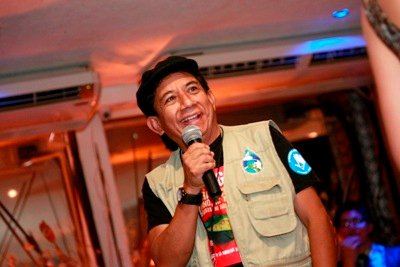 Oscar Olivera, organizer in Cochabamba, Bolivia, believes that it is necessary that activists and organizers, together, weave networks to “fish more people.” DR 2013 Noah Friedman-Rudovsky. |
This Bolivian leader, who organized the population and challenged political power in 2000, is sure that he is still waging struggles “with the transparency and joy of water”.
That year, Olivera and other citizens of Cochabamba learned of the imminent privatization of the region’s water because the local authorities had sold of the rights of usage to the international company, Aguas Turani, part of the multinational corporation, Bechtel.
“At the beginning, when we were invited to participate, I didn’t understand it. What does a factory worker have to do with the Water War? But then I understood that water is a universal issue in the life of every person, of animals, of plants and the earth, and that I had to fight for that,” tells Olivera.
Olivera, with others who arrived early in the struggle, organized the “Coordinadora de la Defensa del Agua y de la Vida” or the Coordinating Committee for the Defense of Water and Life. Olivera quickly became one of the most visible participants when he took on the job of spokesman for the collective. Olivera had to find the simplest way of communicating how privatizing their water would directly affect the life of people – most of them part of vulnerable indigenous communities.
He had to explain why it was imperative that they join forces, raise their voice against authority and stop this menace from happening.
While remembering this period of time, Olivera emphasizes the different challenges an activist and an organizer face during times like these.
“An organizer stands out because he always listens to the people, because he doesn’t feel like he’s better than other people because of his experiences. More so: an organizer has to be the most humble in a sincere manner, not as an imposition. He has to be the last to speak and the first to listen. He has to learn that simple yet profound language of the people so he can communicate,” reflects Olivera.
Olivera and his colleagues began to plan their battle strategy. He knew because of his experience that a social movement without an objective and a plan would get lost amidst protests, repression or disenchantment.
Olivera sat through numerous occasions with participants in the struggle to listen carefully to their stories and their fears of the uncertainty of what they were about to do. They were sharing ideas on how they could help, together, to solve the problem.
Olivera eventually was behind the barricades they built and was even detained and accused of being a “vandal” by the government of then President Hugo Banzer.
Nevertheless, he says that as an organizer he had to call for the people “to face their shared fears and fight for their voice to be heard” through peaceful and artistic means that left a clear message. He would not accept a resolution that imposed a strategy on the people, especially if they had not been consulted first.
These actions let the citizenry of Cochabamba to value the Coordinating Committee’s work and to not to be intimidated by the fact that the authorities were ignoring their statements and demands.
That is why he considers that “activists” are vital for social movements, even though they are not the ones that establish a strategy. What activists bring is the energy “to mobilize and build nets to catch people with, to reach a goal shared by the community.”
Thirteen years after having fought – and won – this battle against authority and the interests of an international company, Olivera highlights that the actions coordinated by the organizers made victory possible.
“What we did was to permanently break a system of exploitation,” he concludes.
From activism to organizing to face
a nuclear menace: Renny Cushing
During the 1970s, the government of the United States announced that it was planning to build two nuclear energy plants in the town of Seabrook, in New Hampshire.
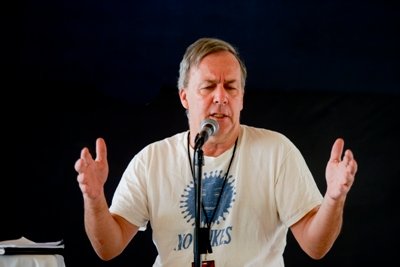 Renny Cushing spoke at a plennary session of the School for Authentic Journalism 2013 about his part in organising a movement against nuclear power that spread across the United States of America. DR 2013 Rodrigo Jardón Galeana. |
Cushing tells that he first thought of posters, marches and normal actions that get people organized to challenge an issue.
Nevertheless, faced with such strong opponents, he understood that a single action wouldn’t be enough, because as activists lost interest in the cause or were disheartened, the government would build the nuclear plants.
Cushing understood that “organizing is the space” from which to push for structural changes in society.
“I think that people can be activists in different ways, not just protesting on the streets. People can be activists talking on the phone to others, not just during demonstrations,” says Cushing.
Following that train of thought, Cushing highlights that “activists can be a part of social movements but it is organizers who lead and change things. The organizer carries more responsibility in the success of a mobilization and in the decisions that have to be made.”
The movement that Cushing was involved in expanded nationally and internationally. The anti-nuclear movement succeeded in placing the discussion about the danger of nuclear energy plants into the local, then national, public sphere.
Cushing believes that an organizer has to have certain character traits in order for his or her cause to reach notoriety.
“It has to be someone independent, with a sense of history, someone who can communicate effectively face to face, who is flexible, someone with a lot of passion for justice and for changing his or her reality,” states Cushing.
Cushing explains that every organizer will find themselves in situations that test their patience and the commitment they have with their movements.
“Problems are always big, hard and there are always moments of doubt. But the passion and love of the people give us strength to fight for justice. A lot of times you are alone and it is important to keep it together to continue with the movement,” reflects Cushing.
According to Renny, moving past protests and marches requires “first of all, a sense of history, of what has happened. You have to try to learn from people who fought before you. At the same time you have to try and understand that the current situation is different from other historical points in time”.
For that, Cushing explains that you have to talk to people, show interest in their side of the story and pay special attention to finding solutions for the groups of people that would be affected in a community.
That same decade in which he fought against nuclear power plants being built, Cushing also organized the first occupation of Wall Street on October 28 and 29, 1979.
Afterwards, he began a career as a legislator and representative for the state of New Hampshire (where they have a citizen led state congress, not professional politicians, who only earn 100 dollars a year). Currently, he continues his work as an organizer as director of the Murder Victims’ Families for Human Rights.
Turning emotion into inspiration:
the work of Paulina Gonzalez in the US
When she was ten years old, Paulina Gonzalez felt great indignity and impotence when she found out that her father, a Mexican immigrant and factory worker in California, United States, was fired from his job for trying to organize a workers union.
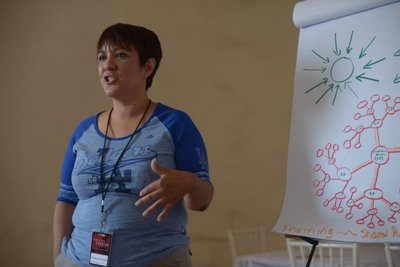 Paulina González, a community organizer from California, explains how to use your personal story as a means to communite with an audience during the School for Authentic Journalism 2013. DR 2013 Rodrigo Jardón Galeana. |
She says her story begins like that of many children of Mexican immigrants to the United Stated. They came to this country looking for better living conditions for their families.
Throughout her life, Gonzalez has taken on different campaigns and social movements, with the purpose of generating change in the most vulnerable communities.
Paulina Gonzalez took her first steps as an organizer when she decided to quit college and work for the United Farm Workers of America. After that, she decided to go back to her studies, finish her degree in sociology from the University of California, and look for a way to continue with her experience of organizing in the union.
Currently, Gonzalez is the director of SAJE (Strategic Actions for a Just Economy), an organization that works to create strategic actions for a fairer economic system.
Her routine as an organizer begins every day at 8 in the morning when she drops off her nine-year-old son at school. After that, her day is made up of meetings, reviewing proposals, following up on current actions, evaluating recruiting plans, training and fundraising for the organization. These tasks, according to her, demand about 60 hours of work a week.
“Organizing is hard work, physically and emotionally, because I don’t have as much time as I would want to be with my son who is autistic. Not being able to help him sometimes ‘til late at night, makes me feel guilty,” she says.
Gonzalez highlights that the organizer takes on a long-term commitment with the people he or she is trying to help.
“Sometimes one tries to do things for the people and it doesn’t work. I go home and they remain. You walk away with that emotion, that guilt, even though you can’t do anything right there and then,” says Gonzalez.
When facing complex cases like these, the community organizer says that she remembers the hard battles that were won, like the time she was with a group of farmers who had been fired for going on strike.
“I was pregnant and there was another farmer who was also pregnant. The people from the company brought a tractor that doused pesticide on us.
“Paradoxically, because of that attack we won the mobilization and I learned that there are always challenges, there is always injustice and that it is a privilege to organize, even if they throw pesticide at us,” she says.
During hard moments, Gonzalez says she draws strength from inside.
“I think of the things I know we can achieve individually and I challenge that emotion into working for change. I transform it into inspiration. thinking of the way it will better people’s lives and their community,” reflects Gonzalez.
As an example, she quotes de story of Mariana, an indigenous lady from Guatemala who could not read or write in Spanish. Mariana could only express herself in her native indigenous tongue and lived in very precarious conditions when they met her and began working with her.
“I felt very indignant and I knew it would take time to win her case. When I feel that way I think of the future and the results we want to get, and I remember moments when we were able to achieve something like it,” explains Gonzalez.
Mariana always cried when she told her story but they quickly saw changes in her. For example: she had never taken the bus. She was very afraid but they told her she had to be a leader, she had to be independent.
“We had a community meeting and we told her we weren’t going to pick her up in a car, that she had to take the bus by herself. The meeting was on Friday and she did a trial run on Thursday: she took the bus to see how long it would take her. She arrived by herself on Friday and she was so proud of having done it on time, that she was more independent. When we asked her to tell her story during the meeting she didn’t cry,” remembers Paulina Gonzalez.
“She spoke of how she was a leader, that she was committed with the organization of this issue and told everybody else how they also have to commit and develop as leaders. It was an incredibly gratifying change,” she finalizes.
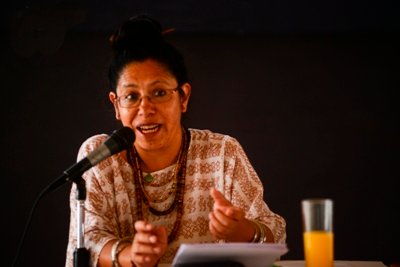 Mercedes Osuna spoke during the 2013 session of the School of Authentic Journalism about the need of organizers to listen with their hearts. DR 2013 Rodrigo Jardón Galeana. |
How a community organizer wins: Mercedes Osuna
Community organizer Mercedes Osuna believes that training and sharing information with the members define the end results of social movement.
Osuna is a leader who, among other things, managed the access of human rights observers, national and international journalists in the indigenous Zapatista communities in Chiapas, Mexico, during the first years of that rebellion in the 1990s.
| When the leader uses the movement |
|---|
| When the leaders of a movement use it to lobby for privileges or personal advances, Mercedes Osuna thinks that it happens because “someone inside a movement can change because; a political party offered a deal, maybe a job or money; because the government is putting pressure on them to become an informant, because they threatened his or her family, or because organized crime lords are pressuring them to work for them.”
Oscar Olivera believes that “when a leader uses a social movement to further his or her career, to get a job within the government’s system, or to make their own political party, that devaluates the leader because people see that as a betrayal, they see someone who used the people.” The solution, according to Paulina Gonzalez, would be to use decentralized methods of organizing where there are subdivisions that don’t allow decision-making powers to concentrate around a single person. That way you can guarantee continuity in the movement even in the possible event of someone profiting for personal motives. |
“If people don’t know, if they are not politically prepared, they cannot have a successful movement. If within us we don’t have that possibility we need to look for tactical allies to help us,” mentions Osuna.
The organizer highlights that a movement has to be in constant analysis of the strategies they use and the results they produce.
“Organizers and activists alike need to understand that it is very important how you articulate a movement. And that work is done by both: establishing bonds with people, or like Oscar Olivera says, like knitting a net,” mentions Osuna.
Moreover, she says that organizers, regardless of the movement they are involved in, they must be prepared to listen to activists and other organizers with all of their senses because “we have to open our hearts to listen to the true word.”
“The community organizer and the activist have to be humble so they can listen. They also have to be aware that when they leave the movement in the hands of activists that have no relationship whatsoever with the movement, they will fail because they are more likely to betray the movement or to make mistakes,” Osuna reflects.
The energy that joins activists
and community organizers: Richard Bell
In the wake of the anti-nuclear struggle in the US during the 1970s, Richard Bell – one of the first journalists to use the Internet as a platform to showcase information and proposals – decided to edit a newspaper that captured the news of the biggest civil disobedience arrest in the history of the United States.
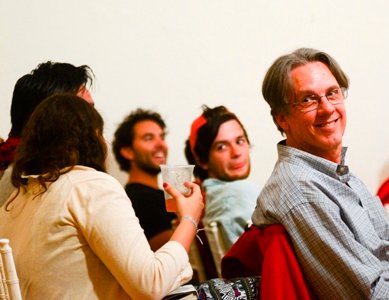 The journalist Richard Bell believes that energy is what brings together activists and community organizers.DR 2013 Rodrigo Jardón Galeana. |
Bell believes that even though activists and journalists have differences, they do have something in common.
“Community organizers and activists exist in the same universe,” Bell remarks.
Following that logic, Bell agrees with Renny Cushing in that an activist can be anybody.
“An activist is someone who wants to involve others in a common cause. For example, you can be an activist on your on by writing a letter to the newspapers, but the next step is to organize.”
Community organizers have a different status because “they have to organize the efforts of activists and they can and should be an activist deep down inside in terms of having the energy to work with other people, calling out to them.”
Bell concludes that every organizer is in essence an activist, but not every activist is an organizer.
“They both are part of the same universe inside a movement and they are both vital to keep it going and push it towards success,” he says.
Challenges for the organizers of the Chilean student movement
In April of 2013, Chilean students took to the streets to take part in the first march for education of the year.
Beyond the 150,000 people with posters participating in the demonstration, one of the challenges the leaders of movement faced is recognizing that these actions – protests, marches and demonstrations – are only tactics.
With that in mind, and the example of other social struggles, like that of Oscar Olivera in Bolivia, the leaders of the student movement need to bring together different parts of society and listen to their concerns.
They have to listen to them in their role as representatives and constantly consider that they have to be transparent in their decision-making.
The numbers shown in polls like Adimark’s show a decrease in citizen support for the movement since 2012 after having reached its peak in 2011. That situation can be reverted according to the work of other community organizers.
For that, it is imperative that the organizers have a planned strategy, discipline and that they commit to the cause long term.
Lea Ud. el Artículo en Español
- The Fund for Authentic Journalism
For more Narco News, click here.




